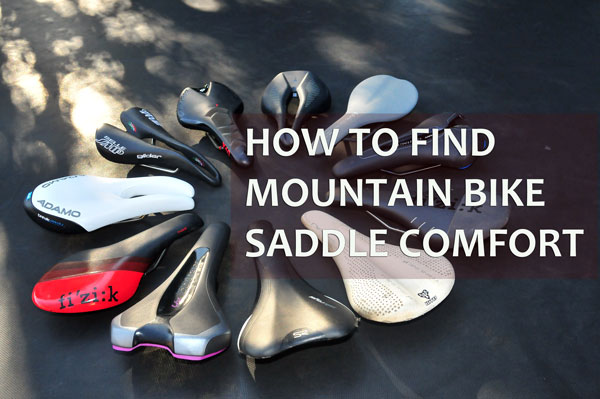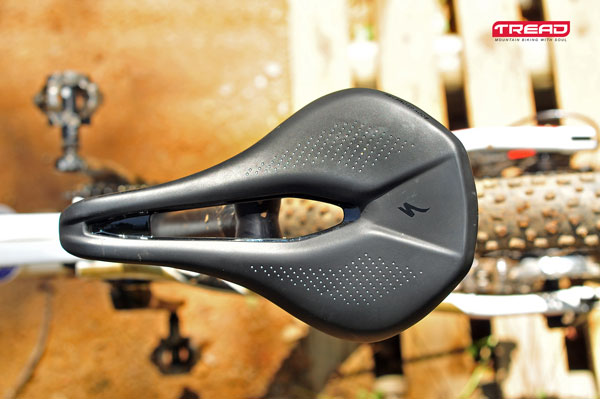No two mountain bikers have exactly the same physiology. We may be similar, but our skeletal structure, body weight, flexibility, quad size, butt size, arm length, torso shape, riding style and riding objectives are likely to differ at some point. The saddle is an important component on our bikes. It needs to be something we like, not despise. So we need to find one that suits us. Many consider comfort to be the priority when finding the right saddle, and that’s not a bad place to start; but there’s more to consider. Following hundreds of thousands of kilometres of experience, here’s what we have decided is important – in order:
Compiled by Sean Badenhorst/Tread Testers
Photos: Dino Lloyd

- SHAPE
We feel that shape is the most important factor in choosing a saddle. The shape will determine the contact with your body more than anything else. There’s a generally accepted saddle shape that’s a rounded isosceles triangle and most saddles offer variations of this shape. Certain saddles have a cut-away groove down the centre, some shallow, some deep and some completely through. Others have a flat, filled centre or slightly convex centre.
Each saddle brand has its own way of determining what it believes to be the most ideal saddle shape. Some brands will have different models aimed at different body types, mostly based on sit-bone width and riding discipline (XCO saddles would be very lightweight, but less comfortable due to less time spent on them).
Most base their shape on scientific research, or experiential research, or a combination of the two. While they can differ quite markedly, they all seem to make sense on some level. But they don’t all FEEL right.
We have ridden with hundreds of saddles and are amazed at how different they can feel, but yet each is claimed to be the perfect perch. And that’s the thing. Most people buy a bike and think that the saddle it comes with is what a saddle feels like. But that’s not the case. Fortunately most of the bigger saddle brands offer test saddles that retailers will let you try out so that you can, through your own riding experience, determine which saddle feels best to you.
- WIDTH
We find width to be key factor in saddle suitability. Both total width (from edge to edge) and sit-bone support width.
Total width: It seems obvious, but saddles that are wide create a greater amount of body contact (mostly with inner thighs/glutes) and therefore raise the risk of friction, which can lead to chafing. They can also affect the alignment of your pedal stroke. A saddle too wide subtly, but constantly forces your knees off their natural horizontal plane when pedalling. We confirmed this on the BioRacer Motion, a sophisticated system that assesses rider stability and symmetry.
Sit-bone width: This is possibly the most critical factor in saddle selection. Because your sit-bones (ischial tuberosities) support your body weight when you’re seated, they need to be supported appropriately. If you have wide sit-bones and use a narrow saddle, your sit-bones will be unsupported and off the edges of the most firm part of the saddle. This will mean that your tender area between your sit-bones will have to bear your body weight, which will definitely lead to discomfort and probably pain.
- DENSITY
Saddle density is more important than you might think. A soft saddle with a lot of yield when sat on sounds more comfortable than a high density saddle, but in our experience, is less so. When you sink into a saddle that’s got low density, you are creating a greater contact patch between saddle and body. The repetition of the pedalling action is bound to lead to chafing. Also, you have less stability and more chance of your pelvis rocking marginally from side to side, which leads to inefficient pedalling. A firmer saddle (not necessarily hard) may take a while to get used to, but in the long run (ride), offers greater stability and efficiency.
- MATERIAL
There are still bicycle saddles made with leather, but the overwhelming majority of performance saddles are made with synthetic materials. A material that’s too grippy will restrict your natural movement on the saddle, while a material that’s too slippery will see you sliding around inadvertently. Leather saddles may be old-school cool and are no doubt great on short-hop bikes; but for bikes intended for long distances or durations, synthetic materials rule. It’s important that the materials are long-lasting and unaffected by weather conditions so that the saddle holds its form/density.
- EDGE SHAPE
Because the inside of your thighs brush against your saddle ON EVERY PEDAL STROKE, it’s important that the side edges of the saddle are rounded and smooth – all the way around.. The less friction here the better. Any kind of hard ‘lip’ (usually at the base of the saddle) will cause a problem.
- LENGTH
There needs to a reasonable length to a saddle, partly because in mountain biking, you need to be able to move forwards enough to keep the rear wheel traction in place when on steep, loose ascents; and partly because you use the saddle to steer the bike. Yes, you may not be aware of it (it’s mostly instinctive), but you do (well you should) lean the bike on small direction changes or adjustments while pedalling.
- RAIL MATERIAL
Every saddle has rails on which to clamp it to the seatpost. There’s pretty much a standard width here and rail length usually depends on saddle length. Rail materials vary from single alloys to alloy blends to carbon fibre. Obviously you want your rails to be reliable and strong. The way they attach to the saddle is important too. A rail that pops out of its connection point is something you don’t want to experience. It’s extremely difficult to reinsert it and it implies either a weakness in design or material; and it’s advisable to get a new saddle…
A quality rail should also have millimetre markings on it so that you can set your saddle position and use that as the starting point should you have to reset it.

MM markings on the saddle rails such as Yeti’s OEM spec WTB saddle assist in positioning the correct adjustment.
- WEIGHT
We feel weight is the least important factor in choosing a saddle. Sure, it’s great to have a light saddle, but light doesn’t necessarily equate to comfort.
WOMEN’S SADDLES
We’re finding more and more brands labeling certain saddle models as unisex. We find this difficult to get our heads around because for the past couple of decades there have been very clear saddle design differences between men and women’s saddles. We’ve been shown, quite convincingly, by most saddle brands, that women have wider pelvic structures than men and therefore need a saddle that has broader sit-bone support in the design. This means a wider saddle.
More recently, large men, who have wider sit-bones than small and medium men, have also discovered that broader saddles are more comfortable. Makes sense really.
Also, most women-specific saddles have a definite groove or full cut-out down the centre of the saddle to minimise blood-flow restriction to the soft tissue in the crotch region. Quite a number of brands incorporate this pressure-relief groove for men too.

Top view of Specialized’s Power Saddle.
Bottom line (Ha! See what we did there), women do have a different pelvic structure to men (wider sit-bones) and should be riding a saddle that offers the appropriate support. Generally, it’s a wider saddle although small women and elite racers that ‘perch’ rather than sit, seem quite content with men’s saddles.
Comfort remains the priority for most women – as opposed to being competitive – and this should be the key factor when purchasing a saddle, ladies.



